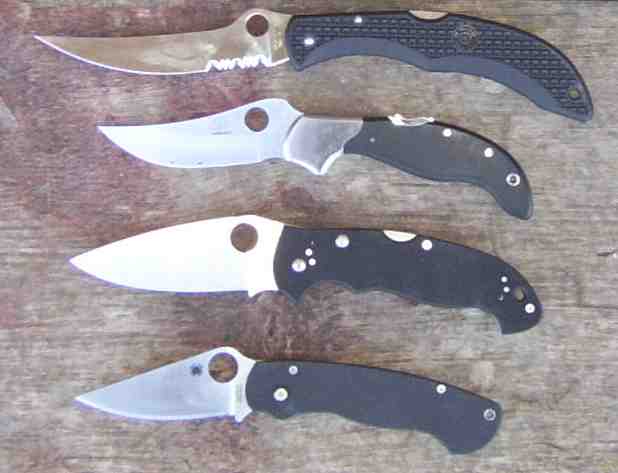
The Spyderco Persian is one of Spyderco's "dress" knives, with a more upscale visual appearance than the working folders like the Paramilitary. This isn't to say that the Persian doesn't have a high degree of functionality, simply that at the same time it is also made to simply look good while doing so.
The Persian weighs 150 grams, ground from VG-10 stainless steel with a hollow grind tapering to a fine and acute edge, 0.012 to 0.020" thick, ground at 17 +/- 1 degrees per side. The handle is polished Micarta on a full metal frame with with stainless steel bolsters.
A shot showing the Persian alongside a Catcherman, Manix and Paramilitary also from Spyderco :

The new in box Sharpness was high. The Persian readily push shaved, easily cut fine paper straight down, and on light thread only took 115 +/- 24 grams to make a cut.
In Shallow cutting it also did very well, push cutting 3/8" hemp required 25.0 +/- 1.1 lbs, with 17 +/- 1 lbs on a two inch draw, showing high aggression inspite of the very high polish, and thus having a complete sharpness profile.
On birch flooring it took 24.6 (3.8) slices to make a point.
In regards to point penetration and strength, the point on the Persian is well formed, slim and acute and with a 50 lbs push sank 226 +/- 13 pages into a phone book and with a hard vertical stab penetrated 673 +/- 18 pages. The point is far to acute to dig aggressively in woods, the 2x4 hole digging was not attempted. If such work had to be done, the point should be used to cut the wood out, not attempt to leverage it.
The Persian works well for light utility use in the kitchen compared to various tactical folders and better than most. It readily dices up onions and makes neat slices of mushrooms :
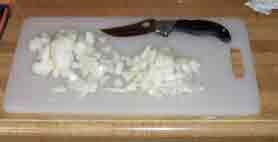
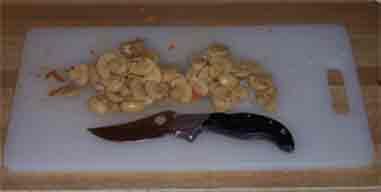
In regards to raw cutting ability, while the japanese utility from Lee Valley take 1-2 lbs to slice up a medium carrot, the Perisan does it in 3-5 lbs and thus compared to the high flat ground blades from Spyderco such as the Paramilitary falls slightly behind in terms of cutting ability, of course such blades set an extremely high standard for cutting ability in working folders.
The biggest difference in regards to feel in the kitchen is the sheer weight of the persian. it isn't massively heavy, only weighing 150 grams, but is almost 50% heavier than the Paramilitary. This extra heft does give some the implication of strength, but the handle on the Paramilitary is strong enough to withstand prying forces which would break the blade so it isn't a functional gain in strength. It simply comes down to a preferance for feel, some like more heft in hand.
Used for precision work such as peeling various vegetables, a high grip is used to get the blade to balance neutrally in hand :
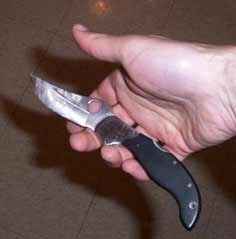
This puts the index finger loose floating around the blade, but it is the grip which gives the lowest fatigue :
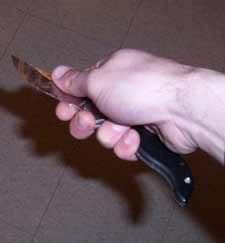
Even then though, in this grip fatigue does set in fairly quickly and after peeling a couple of dozen potatoes it becomes obvious that this knife was designed for other work, for occasion short periods though there are no significant issues :
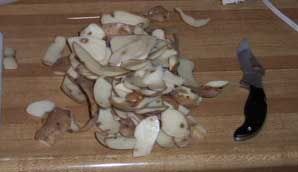
Concerning general blade style, the upsweep of the tip reduces versatility on a cutting board where a straight spine such as on the Paramilitary works better as a scraper. However the Persian cuts well to the board using the highest point on the belly which requires cuts to be made using a draw as direct push cuts can't bring enough of the edge inline with the cutting board to make full slices.
The other downside of the upsweep is that the point is a problematic for coring and other similar work like cutting the root stem out of a tomato. The general sweeping profile however does work well for trimming fats, slicing up meats, and in general working on poultry.
The Persion was used for a variety of work on brush including fire starting, trap making, and shelter and clothing construction.
The Persian readily sweeps out large swaths of grasses, ferns and other light vegetation, however pretty much any blade will do this if well sharpened with the optimal profile being hawkbill patterns like the Harpy which trap the grass and cut very aggressively.
The uses for such vegetation are numerous. Dry grasses make excellent stage tinder for starting fires, fresh green gasses produce huge volumes of white smoke for signaling, both can be used for bedding materials, insulation for the walls of shelters and as extra padding and insulation for clothing in extreme cold. Many types of such vegetation can also be eaten.
To increase the efficiency the Persian can be lashed to a small pole to make a bill hook, which is easier than on many knives due to the fairly flat sides and grooved grip. However the cuts should be either made with fairly light force or the grasses and light brush carefully checked because a heavy swing into a concealed rock would be problematic on a thin hollow ground stainless edge.
It is on small woody vegetation like like Alders where the weight and heft of the Persion is of functional benefit as it allows cutting of cut woods with significantly greater ease than a lighter knife like the Paramilitary. It can't match the ability of the Manix for such work, but it is a lot more effective than most of the FRN models. It easily has enough power to readily cut down Alders of size for thatching and readily whackes off boughs for a debris shelter or bought cave.
Heavier wood work is probably the real weak point of the design in terms of outdoor work. The upswept tip doesn't lend itself to being used with a baton, even lightly because it will dig readily into the baton plus it is a fairly weak point that could be readily overloaded. For similar reasons the thin and acute hollow ground edge would not react well to hitting a knot and twisting. For this style of work a primary flat grind with a straight to dropped point profile like the Manix or Paramilitary would be a much better choice. Often though heavy chopping isn't needed if there are suitable dead woods around :
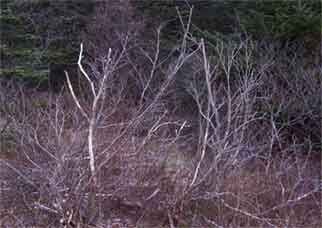
These can serve as fuel for a fire or basic framing materials for a shelter and they are more easily broken than cut, unless a very large knife is used such as a bolo or parang. As well don't overlook resources like root balls :
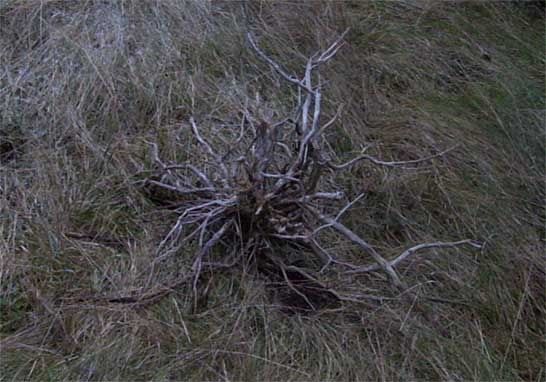
These are excellent to add to a fire once it is going decently well because they allow a lot of air to circulate around the fire and prevent it from collapsing. They are also easily gathered as once they die the roots are easily broken and they can be pulled up without too much trouble. As well dead trees are often a valuable source of tinder :

The strength of the Persian is of use here compared to something a lot slimmer like a Swiss Army knife because the Persian's blade is stiff enough to break apart the rotted woods whereas a slimmer blade would need to whittle it away which would be more efficient. If the wood is really rotted as it can be if infested with ants, it can come apart like cork :
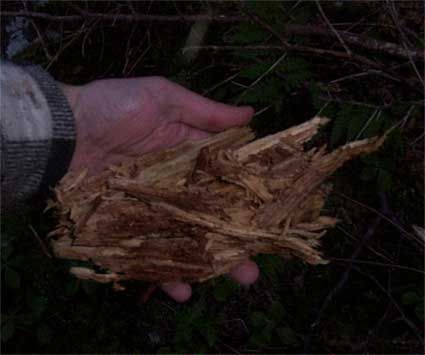
In this state it makes excellent tinder when dry, however it will soak up water very quickly in the rain and takes a long time to dry, however often if the outer layers are broken or cut away the inner part can be dry and useful. If there is a lot of it, it can make decent bedding or insulation for improvised clothing.
In regards to direct chopping ability, the Persian was compared to a Mora 2000 and it actually out chopped the fixed blade slightly by 12 (8) %. However the Persian is a lot heavier (more than 50%) and if used with a baton the Mora 2000 pulls ahead strongly showing the benefit of its very thin blade.
As a word of caution, the chopping comparion between the two blades ran about 500 chops with each on some scrap lumber and freshly felled wood with heavy elbow swings, this was enough to cause the Persian's lock to loosen to the point where it failed to engage. There was also some seperation in the pivot region.
The lock was forced to engage and it again worked fine, however there was some play remaining and obvious effect on the lock. Thus for extended use of this type (which is obviously not part of the design of this knife anyway) limit chopping to wrist action or similar batoning and work close to the pivot not near the tip.
The Persian readily cuts up plastics, the slim point easily going through the sides of a pop bottle and cuts through the bottom of half litre pop bottle with 45 lbs of force :
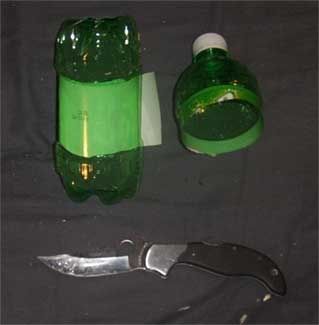
The edge is easily robust enough to cut up CAT-5 cable :
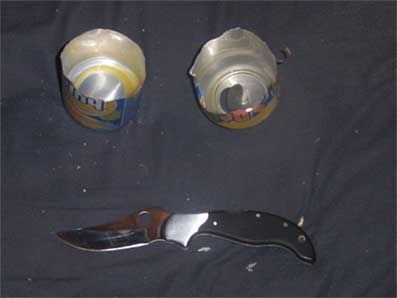
and carve up a pop can easily :
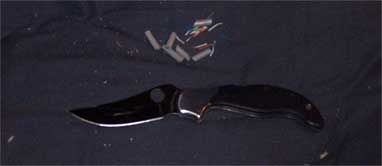
As a first quick pass of edge retention the Persian was used to cut 9.6 m on a slice through the entire blade length :
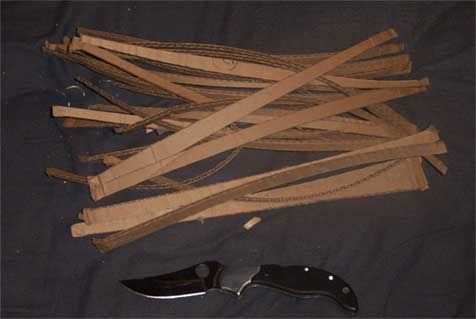
At the end of the cutting the blade was still able to readily slice styrofoam peanuts :
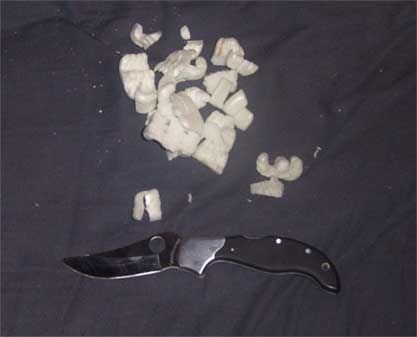
However VG-10 is outclassed on slicing cardboard compared to high vanadium steels like S30V (ref), with the hard carbides which offer better extended slicing aggression : ref.
The Persian's acute edge is honed at a low enough angle so that it can be sharpened on the Sharpmaker without any profiling which raises its ease of resharpening significantly. In general the thin edge responds well to honing and the machinability of VG-10 is higher than steels like S30V so it will allow quicker removing of the same amount of metal. VG-10 generally get high praise for ease of sharpening with few complaints about its sharpness, the Persian is no exception in this regard.
The Persian has an ergonomically contoured grip, large enough to allow varius grip orientations, including a full hammer style grip with or without use of the front index groove. The only concerns are that the stainless liners could be more well rounded and similar for the clip. The most comfortable grip is high sabre :
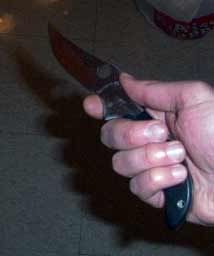
The handle is also well suiited to a reverse grip as well, note how the front guard sweeps into the hand and the rear of the handle flows naturally with the thumb :
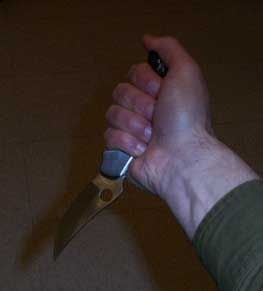
Hammer style also works in both high :
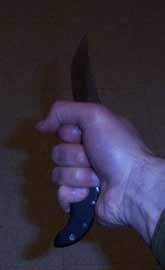
and low :
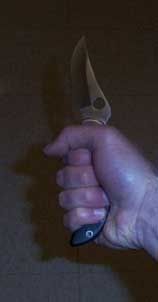
The only grip which is problematic is icepick as the hand doesn't fit well with the contours. Uncomfortable is a hit harsh, but it certainly isn't comfortable or natural feeling in such a grip :
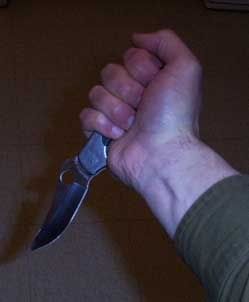
In regards to security, polished Micarta and stainless steel offers little in the way of direct texture retention though there is an integral guard due to the extended index finger groove which is enough to allow even heavy stabs with a clean grip, however if the hand is lubricated with fats or oils, stabbing is be problematic.
The Persian's backlock is stable under spine whacks, torques and white knuckling. In regards to the latter, stability is increased by milling of the lock release bar which acts to prevent accidental releases.
Eight years later the Persian shows very little blade wear, lots of scratches from being carried but not a lot of significant actual use. This was mainly because :
During some stock cardboard cutting a few modifications were made :
The hollow stayed in the front section as it is just deeper there. The slimmed out profile has more of the cutting ability / durability ratio that is personally preferred and the rounded out clip is more comfortable. It still however can not match the modified Paramilitary for general utility or wood work however there are a few interesting points :
In short of pure performance, it can't replace the Paramilitary but it is much more likely now to find itself in rotation a little more.
Comments can be emailed to Persian : eight years in reflection
Most of the pictures in the above are in the PhotoBucket album.
| Last updated : | 15/03/2013 |
| Originally written: | 04 : 25 : 2005 |